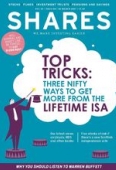Archived article
Please note that tax, investment, pension and ISA rules can change and the information and any views contained in this article may now be inaccurate.
Can you live off a natural yield?

In theory a sensible approach for income-seeking investors, the ‘natural yield’ retirement strategy has been slammed as a ‘bonkers’ tactic that is unsuited to the current low yield environment.
What is natural yield?
The concept of natural yield has been around for generations. Instead of selling your investments to provide income, you only draw the income generated by the investments themselves. This could include dividends from shares, bond coupons and interest on cash.
Proponents of natural yield argue that it is a safer strategy than drawing pension capital because there isn’t a risk of your money running out. In addition, you can pass the intact retirement pot onto your children when you die.
‘The argument is that investors should be focused on income and not the size of the pot, designing the portfolio so cash comes in from coupons and dividends to meet your needs and ensure you can live to the standards you want.
The idea is to take the stress out of gain-hunting and effectively run an immunisation strategy, matching cash out with cash in,’ explains Russ Mould, investment director at stockbroker and self-invested personal pension provider AJ Bell Youinvest.
Why has it come under attack?
Although natural yield is a good theory, in practice it isn’t as easy or safe as it might seem. The yield from investments can vary considerably so your income could be vastly different from one year to the next.
Abraham Okusanya, director at Finalytiq, describes natural yield as a bonkers strategy for all but very wealthy retirees. He says the approach creates an unacceptable level of volatility in retirees’ income and makes budgeting nearly impossible.
‘Once adjusted for inflation, natural income yield is highly unlikely to meet the spending pattern of most retirees, bar the very wealthy,’ Okusanya writes in a recent blog.
Overweighting high-yield asset classes like commercial property and high-dividend equities can be risky because they tend to have large drawdowns, especially during stressful market conditions. During the financial crisis, global real estate investment trusts lost 56% in value and UK equity income assets lost 47%. The drawdowns in emerging market bonds were significantly lower at 14%, according to Okusanya.
Natural yield in a low-yield environment
Deriving an income from natural yield is particularly difficult in the current economic environment of low interest rates on cash and poor yields on fixed interest products. Even if you find a high yielding product, much of the yield will be wiped out by inflation.
Patrick Connolly, head of communications at financial advice firm Chase de Vere, says investors are effectively being forced to take more risk to generate the same level of income.
‘It was previously considered possible to hold a balanced and diversified investment portfolio, including equities, property, fixed interest and cash, and to generate a natural income of around 5% per annum. This is no longer the case,’ he states.
Instead of searching for high yielding assets, Connolly says a better approach is to focus on long-term asset allocation by holding a diversified investment portfolio with an acceptable level of overall risk. If this doesn’t generate enough natural income, you can top this up by making capital withdrawals rather than looking for riskier income options.
This is akin to the ‘total return’ investment approach, which ignores the difference between capital growth and dividends. It seeks to draw income from both in a sustainable way.
Is natural yield suitable for anyone?
Generating a natural income to cover your expenditure might work well if you have realistic income targets and are prepared to take some investment risk. However, you will need a very large pension pot in the first place to be able to generate a big enough yield.
‘If you’re wealthy and your pension isn’t your sole source of income then natural yield could have a role to play. In addition, it might be suitable for someone who has a different agenda – for example constructing their portfolio in the most tax-efficient manner,’ says Jon Wingent, head of portfolio specialists at Lloyds Wealth Investment Office.
Even then, Wingent says investors need to remember that yields can change quickly and significantly. If a stock has an unusually high yield it could be a sign the market is saying the dividend is unsustainable and could be scrapped.
Retirees should think about their capacity for loss and how much money they really need to live on.
‘While income generation will be a key financial goal for many people it doesn’t make sense to try and produce an unrealistically high level of income if this means compromising on your asset allocation strategy and taking excessive levels of risk.
‘Those who do this might have a solution which works in the short-term, but could very easily be storing up problems for the future in terms of volatile investment performance and potentially significant capital losses,’ warns Connolly.
Best of both worlds
Whichever retirement income strategy you choose, it can be sensible to have a guaranteed level of income which at least covers your basic living costs. This guaranteed income is likely to come from defined benefit pension schemes, the state pension and annuities.
‘A guaranteed income can be secured via the state pension and an annuity to cover basic living costs and needs. Investment income, either via income drawdown or other investments, can then be used to fund more discretionary spending which in itself is more variable. This combination of certain income and variable income in retirement is likely to be a good strategy for most people,’ says Mould.
Important information:
These articles are provided by Shares magazine which is published by AJ Bell Media, a part of AJ Bell. Shares is not written by AJ Bell.
Shares is provided for your general information and use and is not a personal recommendation to invest. It is not intended to be relied upon by you in making or not making any investment decisions. The investments referred to in these articles will not be suitable for all investors. If in doubt please seek appropriate independent financial advice.
Investors acting on the information in these articles do so at their own risk and AJ Bell Media and its staff do not accept liability for losses suffered by investors as a result of their investment decisions.
Issue contents
Big News
Editor's View
Great Ideas Update
Investment Trusts
Larger Companies
Smaller Companies
Story In Numbers
- £24.3bn: Personal pension contributions break new record
- 15.7% jump in UK remortgage approvals in January
- Real Estate Investment Trusts
- FTSE All-Share Sectors
- 66%: Potential jump in IMI’s 2017 earnings per share
- 24%: US worst offender for cyber-attacks
- $6.47bn: Warren Buffett’s costly mistake
- 10 years: First dividend growth in a decade from Intu

 magazine
magazine








